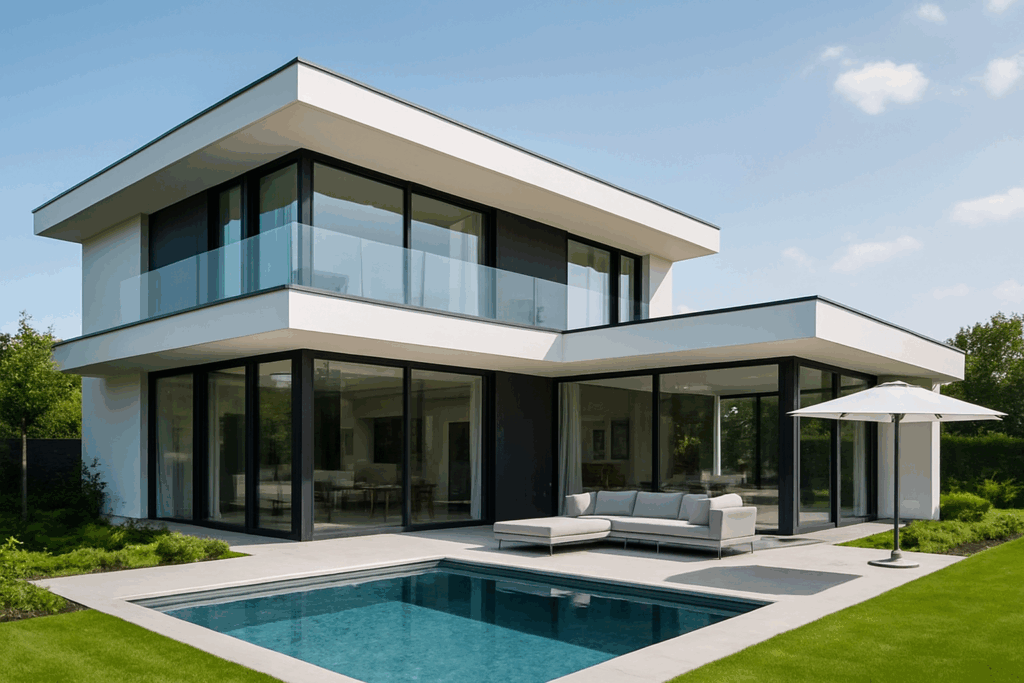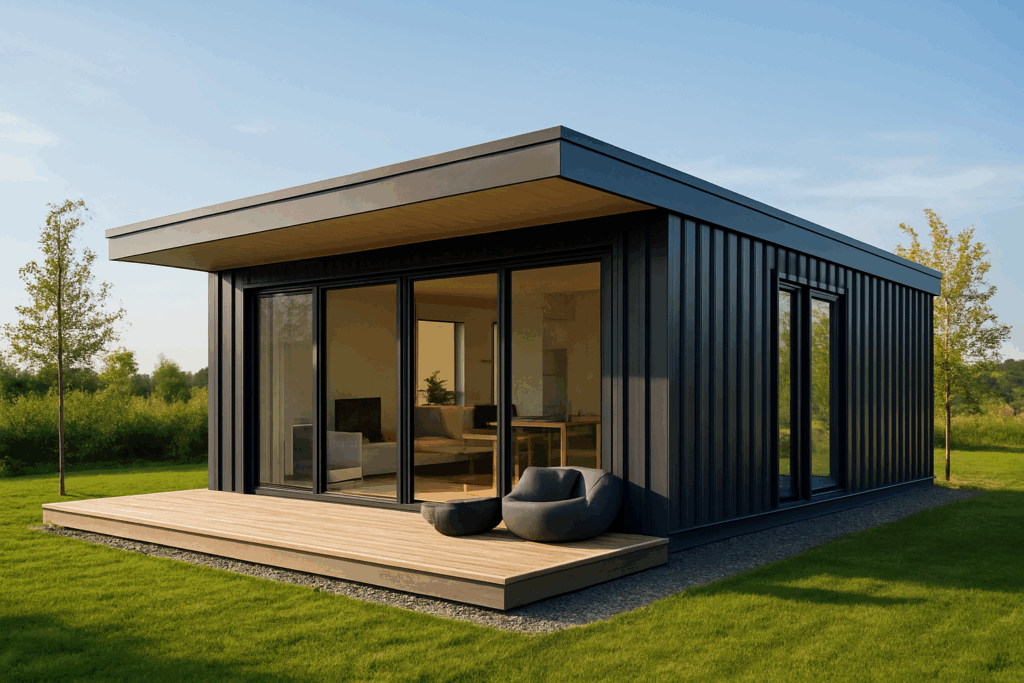When planning to build or renovate a home, one of the biggest design choices is the type of roof. While pitched roofs have dominated traditional architecture, modern homeowners are increasingly turning to the flat roof house design. With its minimalist look, cost-effectiveness, and functional benefits, a flat roof house is becoming a top choice for urban and contemporary living.
This article explores the benefits, drawbacks, designs, materials, maintenance tips, and costs in detail, helping you decide whether this style is right for your dream home.
What Is a Flat Roof House?
A flat roof house is a residential structure designed with a roof that appears almost level. While no roof is completely flat (there’s usually a slight slope of 1–10 degrees for drainage), it looks horizontal compared to the steep pitch of traditional roofs.
Key characteristics:
- Minimal slope (just enough for water runoff).
- Modern, sleek design.
- Offers additional usable space on top.
Difference from pitched roof houses:
- Flat roof house = cost-effective, modern, space-efficient.
- Pitched roof house = traditional, more expensive, better natural drainage.
Benefits
A flat roof house comes with several unique advantages that make it appealing to homeowners.
1. Affordable Construction
- Requires fewer materials than pitched roofs.
- Faster construction process.
- Lower labor costs.
2. Stylish & Modern Aesthetics
- Perfect for minimalist and contemporary designs.
- Sleek horizontal lines create a futuristic look.
- Popular in urban homes, villas, and luxury apartments.
3. Extra Usable Space
- Can be used for:
- Rooftop gardens.
- Solar panels.
- Rooftop lounges or terraces.
- HVAC units or water tanks.
4. Easier Maintenance & Access
- Safer to walk on than sloped roofs.
- Easy to clean gutters and inspect damages.
- Quick access for repair technicians.
In short: A roof house combines functionality, style, and affordability, making it a practical choice for modern families.

Drawbacks
Like any design choice, a flat roof house comes with certain disadvantages.
1. Drainage Issues
- Water can collect if slope or drainage system is poor.
- Requires regular cleaning of gutters.
- Needs waterproofing to avoid leaks.
2. Shorter Lifespan
- Flat roofs generally last 15–30 years, depending on materials.
- Pitched roofs with tiles or shingles may last 50+ years.
3. Insulation Concerns
- Flat roofs absorb more heat in hot climates.
- May require additional insulation layers in cold regions.
4. Weather Limitations
- Not ideal in heavy rainfall or snow-prone regions.
- Can be damaged by extreme weather if poorly maintained.
Flat Roof House Design Ideas
Modern architecture has embraced the flat roof house in various creative ways.
- Green Roof Design 🌱 – Covered with plants and grass for eco-friendly living.
- Rooftop Terrace 🏡 – Perfect for barbecues, evening relaxation, or family gatherings.
- Solar-Powered Roofs ☀️ – Install solar panels to generate renewable energy.
- Luxury Modern Villas 🏠 – Sleek designs with glass facades and minimalistic shapes.
- Container Homes with Flat Roofs 📦 – Trendy, budget-friendly, and sustainable.
Comparison: Flat Roof House vs Pitched Roof House
| Feature | Flat Roof House | Pitched Roof House |
|---|---|---|
| Cost | Lower | Higher |
| Style | Modern, sleek | Traditional |
| Usable Roof Space | Yes (terrace, solar) | Rarely usable |
| Drainage | Needs attention | Naturally efficient |
| Maintenance | Easier | More difficult |
| Durability | 15–30 years | 40–60 years+ |
This table highlights why many homeowners are now considering the roof house design for urban living.

Flat Roof Materials & Construction Options
Choosing the right material is essential for the durability of your flat roof house.
- Concrete Flat Roof – Durable, long-lasting, widely used.
- Bitumen Roofing – Affordable and waterproof.
- EPDM Rubber Roofing – Flexible and weather-resistant.
- TPO & PVC Roofing – Energy-efficient and reflective.
- Green Roofing Systems – Eco-friendly but more expensive.
Maintenance Tips
To make your flat roof house last longer:
- Inspect your roof twice a year.
- Clean gutters and drainage systems regularly.
- Apply waterproof coatings to prevent leaks.
- Install high-quality insulation for energy efficiency.
- Repair cracks and damages immediately.
Pro tip: Schedule professional inspections every 2–3 years to prevent costly repairs.
Cost of Building a Flat Roof House
The cost of building a flat roof house depends on several factors.
Average Cost
- $50 – $120 per square foot (varies by region).
Factors Affecting Cost
- Type of roofing material.
- Size and complexity of the house.
- Labor charges in your area.
- Additional features (rooftop garden, solar panels, etc.).
Long-term savings:
- Easier installation of solar panels.
- Lower construction costs.
- Reduced heating and cooling expenses (with proper insulation).
Pros and Cons (Quick Summary)
Pros:
- Affordable construction.
- Modern design.
- Extra usable space.
- Easy maintenance.
Cons:
- Shorter lifespan than pitched roofs.
- Requires proper drainage.
- May need extra insulation.
FAQs About Flat Roof Houses
Q1: Are flat roof houses cheaper to build?
Yes, they require fewer materials and are generally less expensive to construct.
Q2: Do flat roofs last long?
Typically 15–30 years depending on the material, though proper maintenance can extend lifespan.
Q3: Can you put solar panels on a flat roof house?
Yes, flat roofs are perfect for solar panel installation.
Q4: How do you stop water pooling on a flat roof?
Install proper drainage systems and waterproof membranes.
Q5: Are flat roof houses suitable for all climates?
They work best in dry or moderate climates; extra protection is needed in heavy rain/snow regions.
Conclusion
A flat roof house offers a perfect balance of modern aesthetics, functionality, and affordability. While it comes with challenges like drainage and insulation, proper construction and regular maintenance can eliminate most drawbacks.
If you want a stylish, space-efficient, and cost-effective home design, a flat roof house is an excellent choice. Whether you dream of a rooftop terrace, a green roof, or solar-powered living, flat roof houses provide endless possibilities for modern homeowners.